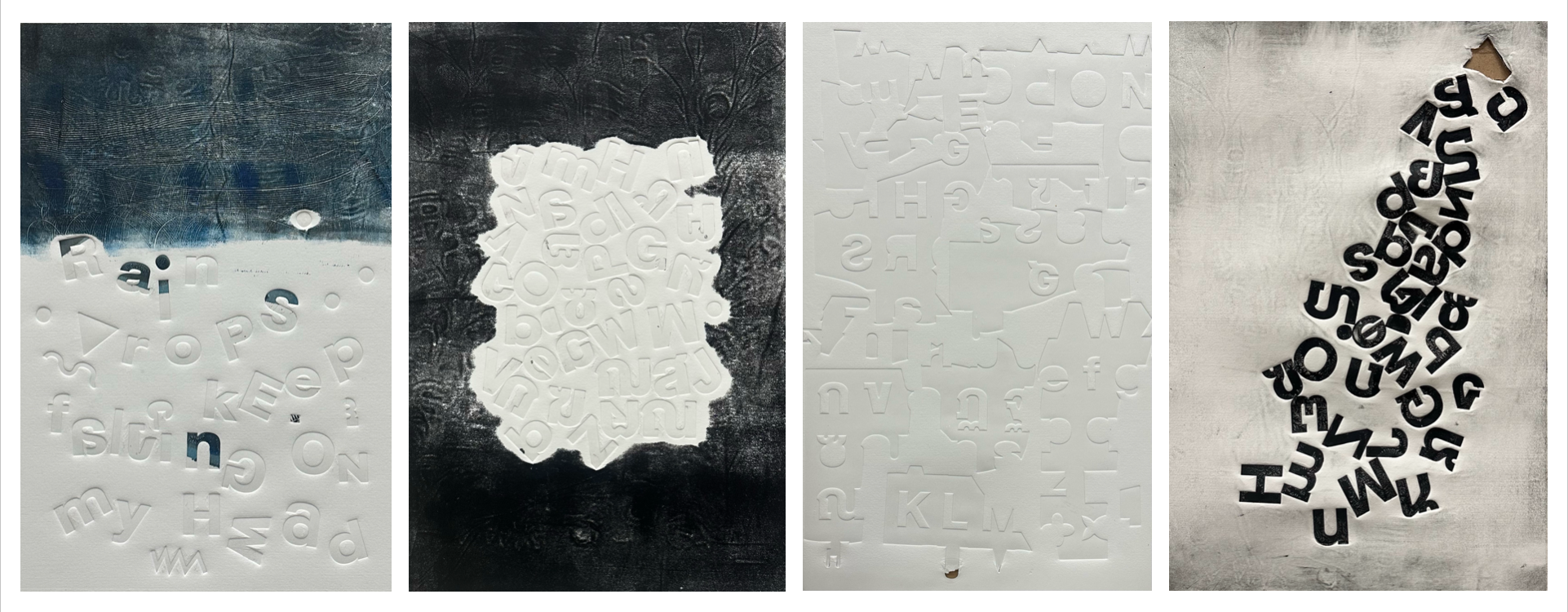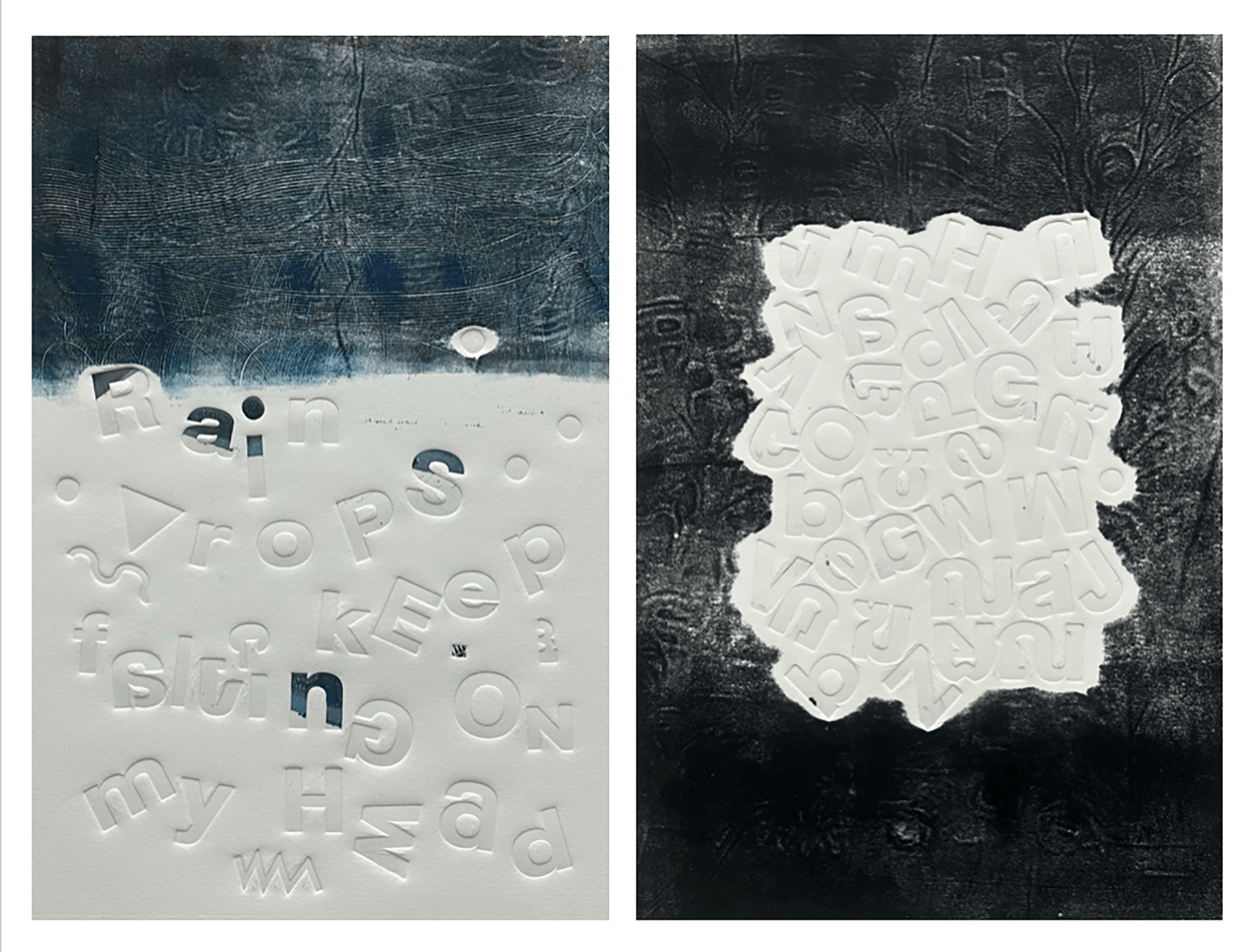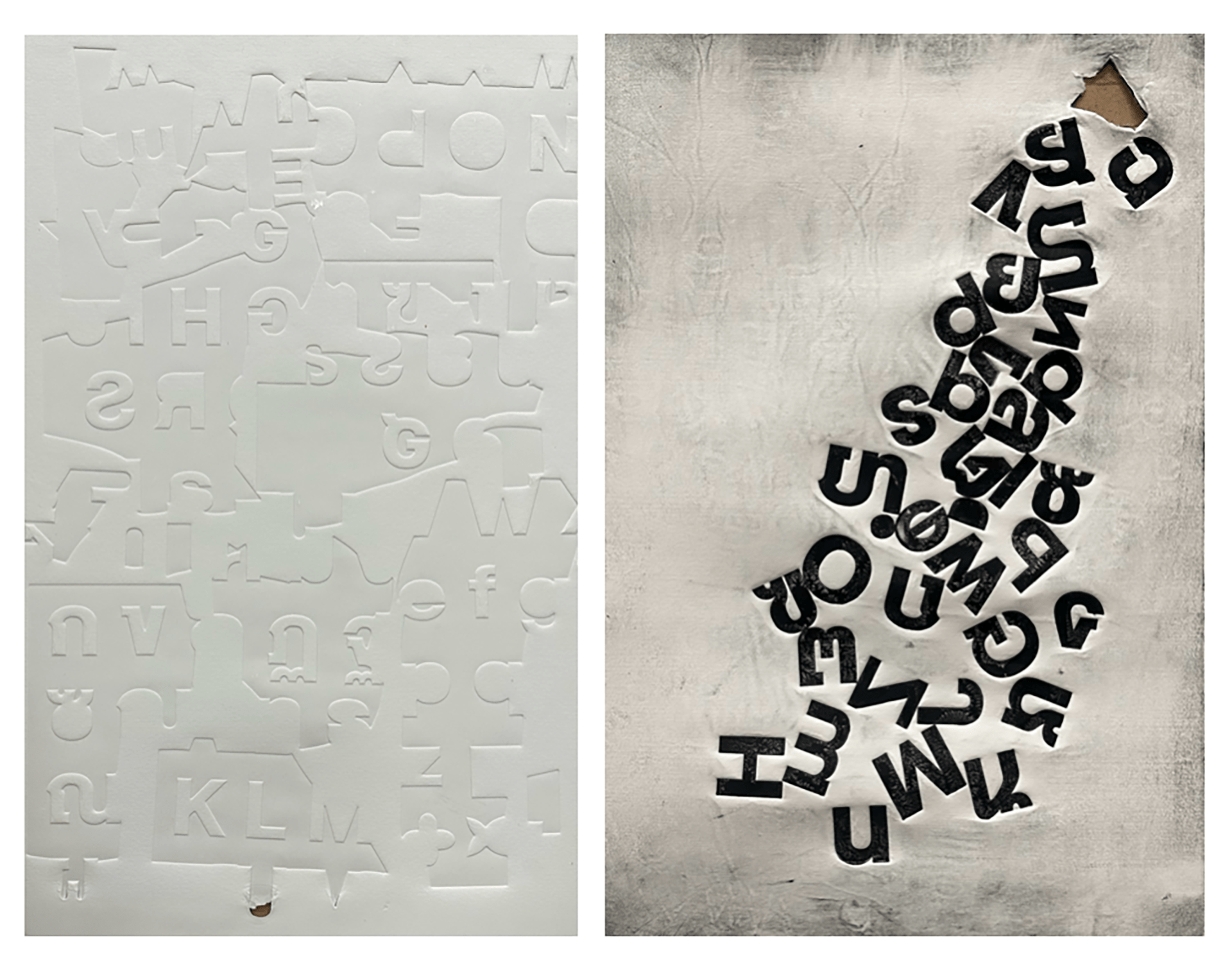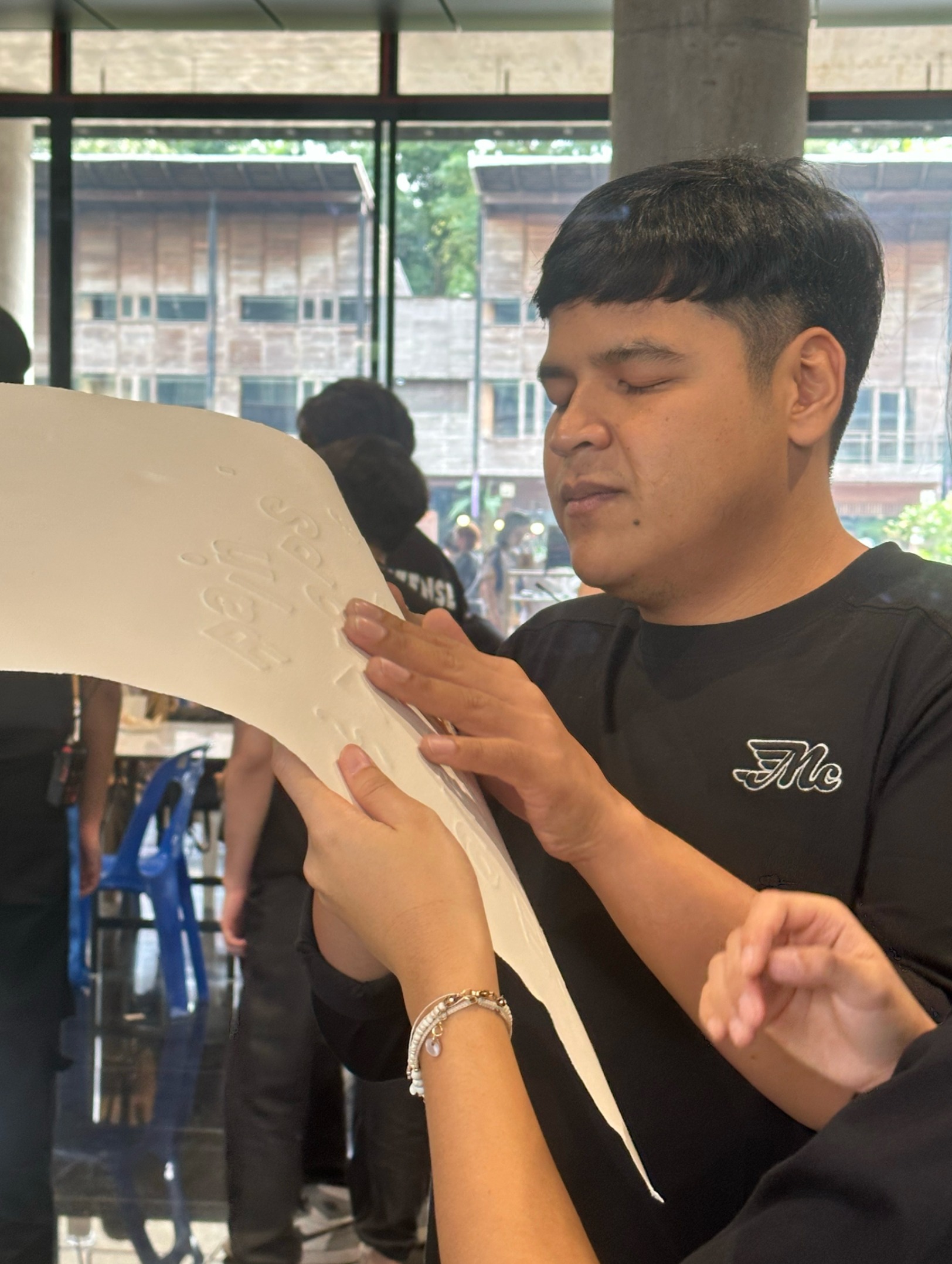
Mahidol University International College
Napatt Piyawongwatthana




Abstract :
About 10 percent of disabled populations in Thailand are visually impaired. Approximately 200,000 of Thailand’s 2 million with disability cards are blind or visually impaired (World Blind Union – Asia Pacific, 2023). Numerous visual impairments face many challenges in accessibility, employment, and education (Disability and Poverty in Thailand – The Borgen Project, 2021). In the realm of art and design areas, the encounter barriers when experiencing art as most of the exhibition and artworks are primarily designed for sighted audiences.This study will explore printmaking techniques that have been conducted in Traditional Techniques Studio class at Mahidol University International College to create artistic experience for the visual impairment individuals. Following the concept of Braille-inspired print, which allows users to see through touch by utilizing embossing and debossing techniques. This project aims to provide equal opportunities for people of all skills to engage with art. This project is designed by transforming visual elements into tactile forms to help the visually impaired build imaginative images in their mind and experience art through the power of touch. The series of print were created under the theme and titled “The Quietude Echo” The making process of the embossing and debossing prints are shown in Image 1-3 below (Image 1: The process of making print, Image 2: Outcomes of the prints, and Image 3: Embossing and Debossing workshop at SZENSE Music Festival at The College of Music, Mahidol University, Salaya. In conclusion, this project shows how tactile printmaking techniques can help individuals across all skill levels. It provides equal opportunity for all to gain newfound confidence in their artistic abilities and engage in making improvements creatively for the betterment of all individuals.
Objectives :
- To provide equal opportunities for people of all skill levels to appreciate and experiment with art and printmaking.
- To help visually impaired people to build a picture in their mind and visualize through the power of touch.
Conceptual Framework :
The project follows the “Double Diamond” framework (2007) from the Design Council, which breaks down the development process into four steps including define, develop, deliver, and discover.
First step is “Discover.” This step focuses on testing with various materials and printing papers to identify the most effective combinations for the blind in embossing and debossing techniques. The exploration examines different substrate properties including thickness, flexibility, and durability, while also experiment with various embossing materials eg. metal plates, Acrylic sheet, thick paper, and cardboard. Through testing, this process aims to determine which materials create the most distinct, durable, and legible tactile impressions, establishing guidelines for accessible tactile artworks for the visually impaired.
The second step is “Define.” In this phase, materials were carefully selected, with the embossing plates made of thick and durable materials. The experiment of materials include; MDF board, cardboard (white-gray thick paper), and acrylic board. Furthermore, the printing paper was selected based on specific criteria including flexibility, durability, thickness, and tactile qualities. The diverse materials included standard 200-gram paper, professional-grade Fabriano printmaking paper, and premium 270-gram Mohawk paper, each offering unique characteristics for embossing and debossing techniques. Ultimately, an acrylic board was chosen as a plate, Fabriano paper for art print and 270-gram Mohawk paper were selected for the workshop.
The third step is “Develop.” This step emphasizes on using carefully selected materials- acrylic board, Fabriano paper and Mohawk paper to create artworks through embossing and debossing techniques. Additionally, the process incorporates monoprint (one-of-a-kind print) to introduce unique textures and distinctive marks in the pieces. The series of artworks drawn an inspiration from four songs; Raindrops Keep Falling On My Head, Broken Pieces, อยู่ภายในใจเป็นหมื่นล้านคำ (A Million Unspoken Word) and Fallin. The artistic approach is broken into two major styles: first where letters are arranged to visually the song’s title with primary focus on compositional balance; and second, where the arrangement follows the concept and narrative of the song in textual form, creating a connection between visual elements and musical meaning.
Last step is “Deliver” is the last step. The most successful prints were showcased in an unframed that allows everyone to see and touch in an exhibition and featured in an Embossing and Debossing workshop held during the SZENSE Music Festival at the College of Music, Mahidol University, Salaya.
Process / Methodology :
The design process began with exploring and collecting various materials to experiment, seeking for the most efficient materials for a person who is blind with embossing and debossing techniques. An acrylic board was selected to be a plate while professional Fabriano paper and 270-gram Mohawk paper were chosen to be used as printing paper.
Laser cut acrylic board into small pieces of Thai and English (both uppercase and lowercase) alphabets. The artworks were completed in two styles. First, letters were arranged in compositions on registration marks. Second, monoprint technique was used (monoprint is a one-of-a-kind print, also known as a unique or painterly print which can only be produced once, unlike other printmaking processes). After inking the plate (a recycled aluminum lithograph plate), the acrylic letters were arranged over in composition. Later, moistened paper, which better absorbs pressure and captures fine details, was placed over these arrangements. When it passes through the hard pressure of the printing press, the thickness of letters created raised embossing and recessed debossing effects on the paper. Lastly, all artworks were straightened on wooden boards using water-masking tape.
Around 60 people participated in the Embossing and Debossing workshop. Participants include Normal and people with disabilities.
The outcome of materials testing
| No | Material | Strength | Weakness |
| 1 | Acrylic board |
|
|
| 2 | MDF Board |
|
|
| 3 | Cardboard
(white-gray paper) |
|
|
The outcome of paper testing
| No | Paper | Type | Strength | Weakness |
| 1 | Fabriano paper | Heavyweight
Cotton based paper |
|
|
| 2 | 270-gram Mohawk paper | Heavyweight
Premium recycled grade paper combining the tactile feel of uncoated paper with the sharp detail of coated |
|
|
| 3 | Standard 200-gram paper | Heavyweight |
|
|
Techniques and Materials :
Embossing and Debossing are selected to be the main techniques. The techniques used to create raised or recessed effects on materials. Embossing creates a raised effect while debossing gives the opposite outcome of embossing in which the design will be recessed on materials.
In this study, embossing and debossing effects are fully illustrated in work 1. The process begins with aligning cut out shapes of letters and broken pieces of acrylic board onto the mark. Then placed dampened paper over and put it through the hard pressure of the printing press. Once opening paper up the areas of relief acrylic pieces create a recessed effect of deboss while the gaps in between little pieces and letter of acrylic sheet create the raised effect of embossing.
Work 2-4, Monoprint; one-of-a-kind or known as a unique print is utilized to introduce unique textural elements and colour combinations to show greater artistic expression. Once the aluminum plate is inked, various types of recycled materials were drawn over for creating textures and marks which would appear at the background. Then, cut-out acrylic letters were placed on top of the plate. Artistic processes and principles of arrangement were applied. Next, moistened paper was placed above and passed through the printing press. The areas where acrylic pieces were positioned over the monoprint plate appeared white as they blocked the color from the monoprint plate, simultaneously creating embossing and debossing effects.
Result / Conclusion :
According to the objective the results were analyzed by SWOT Analysis shown below.
| objective | Strengths | Weaknesses | Opportunities | Threats |
| 1. To provide equal opportunities for people of all skill levels to appreciate and experiment with art and printmaking. | – Encourage participation from diverse individual for all skill levels
– Creative expression for all to explore their creativity – Promote traditional techniques |
– working with the blind may require additional materials | – enable to collaborate to the disability groups and allow them to enhance and experience art
– raise awareness of inclusivity so that society can concentrate more on accessibility and universal design |
– Techniques limitation: some printmaking techniques may not suitable for visually impairments
– |
| 2. To help visually impaired people to build a picture in their mind while touching the art and visualize through the power of touch | – Enhance accessibility and more understanding in art
– Helping people to create visual imaginary without rely on sight |
– Different person can perceive textures and reliefs differently which lead to misunderstand-ing easily
– The variety of artistic expression may be limited by the difficulty of accurately translating certain textures. |
– collaboration with the disabled organization to having workshop and provide opportunity for them to enhance art
– Expand to other fields in which tactile visualization can benefit educational in art, design and architecture – raise public awareness |
– Lack of institution support
– high cost for creating the pieces |
To reply to the objective, this project illustrates that tactile printmaking techniques (embossing and debossing) effectively provide artistic experiences for all individuals, especially those with the visually impaired. “The Quietude Echo” series and the workshop successfully transforms visual art into approachable tactile experiences through the use of embossing and debossing techniques. Despite difficulties with texture perception, the result of the series of this print increased accessibility, a variety of creative expression, and the encouragement of traditional practices to the blind. The project could also raise awareness about inclusivity and open doors for engagement with disability organisations.
Additionally, this piece shows how tactile art can overcome sensory barriers and enable multimodal participation for the benefit of everybody.
References :
Fick, B. and Grabowski, B. (2016) Printmaking. A Complete Guide to Materials & Process. rev. Ed. London: Laurence King.
Hughes, D.A. and Vernon-Morris, H. (2023) The printmaking bible: The Complete Guide to materials and Techniques. Kent, U.K.: Search Press.
Country report from Thailand to the mid-term Regional General Assembly, Thailand, 27-29 November 2023. World Blind Union Asia Pacific. (2024, April 8). https://wbuap.org/archives/1589
Philipp, J. (2024, May 30). Disability and poverty in Thailand. The Borgen Project. https://borgenproject.org/disability-and-poverty-in-thailand/